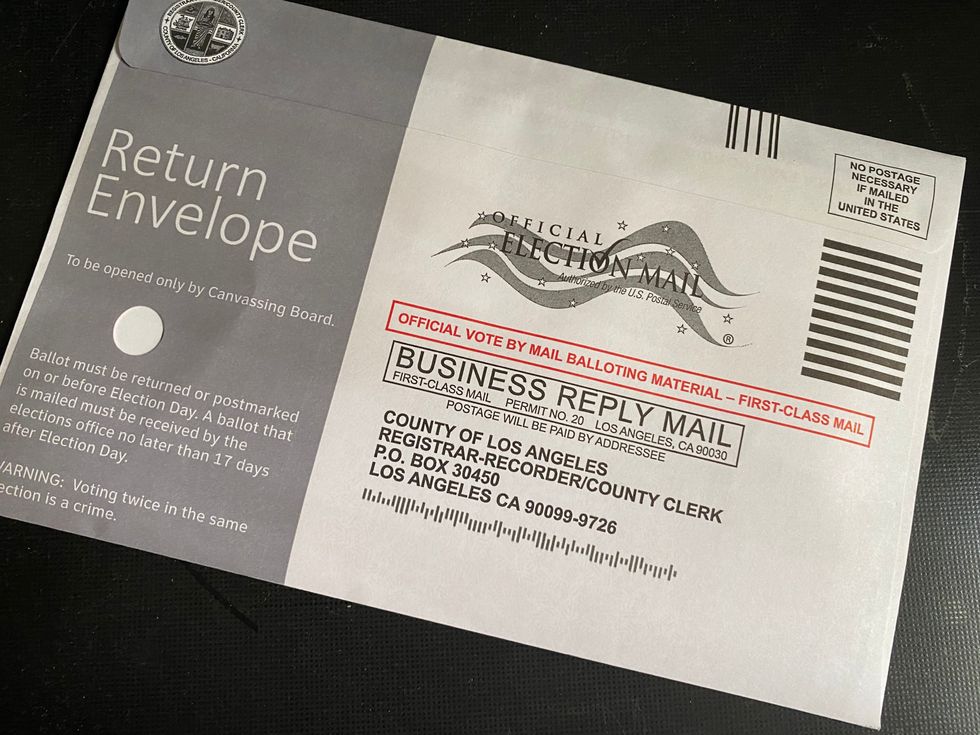How to Correct a Mistake on a Ballot
Tami Abdollah was dot.LA's senior technology reporter. She was previously a national security and cybersecurity reporter for The Associated Press in Washington, D.C. She's been a reporter for the AP in Los Angeles, the Los Angeles Times and for L.A.'s NPR affiliate KPCC. Abdollah spent nearly a year in Iraq as a U.S. government contractor. A native Angeleno, she's traveled the world on $5 a day, taught trad climbing safety classes and is an avid mountaineer. Follow her on Twitter.
Minutes into filling out my absentee ballot last week, I was momentarily distracted by my dog Seamus. A moment later, I realized in horror that I was filling in the wrong bubble — accidentally voting "no" on a ballot measure that I meant to vote "yes" on.
It was only a few ink marks, but it was noticeable enough. Trying to fix my mistake, I darkly and fully filled in the correct circle and then, as if testifying to an error on a check, put my initials next to the one I wanted.
Then I worried. As a reporter who has previously covered election security for years, I went on a mini-quest trying to understand how a small mistake can have larger repercussions.
As Los Angeles County's 5.6 million registered voters all receive ballots at home for the first time, I knew my experience could not be unique. But I wondered, would my vote count? Or would my entire ballot now be discarded?
There are reasons enough to worry about mail-in-ballots counting, even without the appearance of fake ballot boxes and the unfounded rhetoric that has filled the nation's airwaves over the last months. After all, much of the information I found online told me to notify a poll worker if I made an error. Alas, no poll worker at home.
"I don't think your experience is unique, and it's exacerbated by how big L.A. is," said Eddie Perez, election administration and technology expert with the nonpartisan, nonprofit OSET Institute. "These experiences are happening across the country [as] many voters are voting by mail the first time and they don't know what to do. It's a microcosm of all of this change."
Part of the problem was that I didn't receive my sample ballot beforehand and so didn't engage in the practice round I typically do. Worse though, the instructions that came with my ballot said nothing about what to do if you accidentally make the wrong choice. The only advice is to call a phone number or go online and request a new ballot. Does that mean the whole thing won't count? But it was such a small mistake.
"That's a failing right there, the fact that they didn't include it on the instruction sheet," said Perez, who previously worked for Hart Intercivic, voting technology company, and has made thousands of ballots in his career. He noted that in Colorado, the instructions for how to correct a mistake are on the ballot instructions.
I called the phone number, but couldn't get through to a person. I then sent an email to a recommended public address asking if my ballot was "spoilt" and if I needed a new one.
Then, for hours into the night and through early the next morning I searched the vastness of the internet for an answer.

My distractingly sweet dog, Seamus.
Photo by Tami Abdollah
Someone asked about whether you could use whiteout to blot out the mistaken choice. The consensus online seemed to be "no" that the ballot could seem tampered with. One Washington Post opinion article from 2018 argued that any efforts to rectify a ballot should invalidate it entirely. Another recent article by KQED said that you should put a line or X through the wrong choice and that would be fine. Sadly, I'd already made a different mark by the proper choice. I read stray marks can also be a problem and invalidate the ballot. Are initials considered stray marks?
Kim Alexander, president of the nonprofit, nonpartisan California Voter Foundation, empathized, noting that "vote by mail shifts the responsibility of getting it right from poll worker to a voter, and that's a big change. It's not insignificant" or easy, and the rules usually differ between counties.
The next morning I called the L.A. County Registrar-Recorder/County Clerk's helpline and was connected to a worker whose garbled voice seemed to match my emotions. I presented my dilemma.
"Hmmm it doesn't say anything about that here," the worker told me. "I'll have to put you on hold."
After several more minutes of terrible hold music, she told me her connection was bad because she was working from home, and she would call me back. It didn't happen.
When I called the registrar's office back, I was told there was a 35 minute wait for a human being.
The worker who called me back told me that the specific measure I improperly filled out would not get counted, but the remainder of my votes should. I asked if my initials would present as stray marks and invalidate my ballot, and she said it shouldn't.
Over the course of those two days, I wondered if it was best to get the ballot sent in early even if one measure didn't count, or if I should just go vote early in-person.
Because Los Angeles County ballots go through an optical scanner, I wondered whether a human being would review the ballot or if any discrepancy is tossed. There is little reporting about how the county handles mail-in ballots, especially at scale. Is there a human being who reviews the process? A bipartisan team? How technically savvy is the scanner and what exactly can it differentiate?
The registrar's office never replied to repeated official calls and emails for answers to those questions.
Perez, the elections expert, told me that in his experience a mistake should not invalidate the entire ballot and that most modern digital scanning technology "should flag contests with questionable marks and present them to human reviewers" who can discern the voter's intent and make sure it's properly recorded.
Both Perez and Alexander also introduced another potential wrinkle I had not even thought about: In some states having personally identifiable information on a ballot — possibly like my initials — could invalidate the ballot because state laws could see that personal information as a violation of the secrecy of the ballot. Ack!
Perez said part of the problem with mail-in ballots is that unlike the traditional Election Day infrastructure, unless election officials make proactive efforts to provide more details, there is less knowledge about how votes are processed and counted when they are mailed in.
"It places a really big burden on the election officials [to] have resources to answer all these questions," Perez said. "How are you ensuring you have good factual information and you're passing it to all the worker bees you just hired?"
Neither Perez nor Alexander could say for sure what would happen with my initials on the ballot. Both thought it should probably be fine, but perhaps it would violate vote secrecy.
"You stumped the band," said Alexander, who added she was considering updating their own FAQ for voters.
 My sadly imperfect ballot. Photo by Tami Abdollah
My sadly imperfect ballot. Photo by Tami Abdollah
There are many more ways to make a mistake when mailing in your ballot, in one fashion or another. The Associated Press reported this summer that "more than 100,000 mail-in ballots were rejected by California election officials during the March presidential primary." Among those were 27,525 which didn't have a signature or didn't have a signature match the one on record. A friend of mine was one of those, and she trekked out to vote early and in-person because she couldn't recall what her on-file signature looked like.
I had no issues with my signature, it's been the same for decades, but I felt a little bereft over my supremely non high-tech problem. I continued to cull through the interwebs.
It was only much later, after searching diligently online by various keywords, that I stumbled upon a seemingly definitive answer in the latest version of California's Uniform Vote Counting Standards. It turns out, whiteout, check marks, X marks and even writing "no" or "yes" can help confirm the vote you meant to cast. It's unclear what the optical scanner can do or whether the county has a human involved in the process though. And there was, sadly, nothing about whether initialing a choice would invalidate the secrecy of my ballot or be considered an invalid "random marking."
My angst was alleviated when the decision was taken out of my hands. The registrar's office emailed me back, and without answering my question about if the ballot would have been counted, they told me a new one would arrive in five days.
The reply did open up a whole new line of unanswered questions. I mean, is the existence of a second ballot invalidating? I emailed back: "What happens to my old ballot? How do I get rid of it?"
(The first ballot is automatically suspended to issue a second one, I later learned. And you can tear it up or put it through a paper shredder.)
And still, the question remains — what if I had mailed in that ballot.
Alexander also went down the rabbit hole with me, emailing me on a Saturday morning that she "woke up annoyed by our collective inability to answer" the question. She dug around and found that a 2011 California law known as the "Doodle Law" would have likely been applied in my case. It states that rather than reject a ballot that is marked in a way to identify a voter, that election workers separate and duplicate the ballot (without the problematic identifier) like for other defective ballots, before running it through the scanner.
So there it is, my vote would have probably counted if I had mailed in my ballot. But now I'll be sending a brand new on instead. In the end, it's clear that the state and local authorities have tried and are trying their best to ensure that all mail-in ballots count regardless of very normal human mistakes (see this sidebar on how to up those chances).
But my takeaway lesson from all this is that it's probably best not to make a mistake in the first place when voting by mail, oh, and maybe put your dog in a separate room while you vote.
___
Hit me up if you have any other election and voting-related questions. My DMs are open on Twitter @latams You can also email me at tami(at)dot.la, or ask for my contact on Signal, for more secure and private communications.
How to Correct a Mistake on a Ballot
Source: https://dot.la/how-do-you-fix-a-mistake-on-your-ballot-2648194450.html